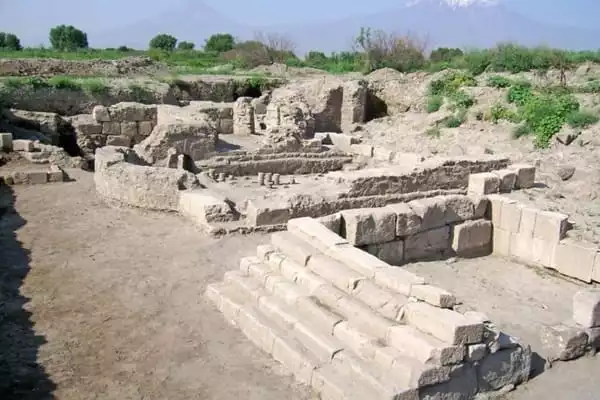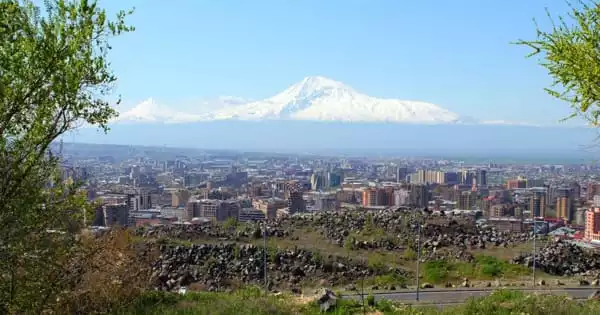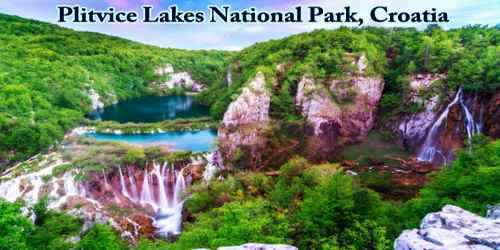During excavation operations on the Hellenistic royal city of Artashat-Artaxata in ancient Armenia, archaeologists unearthed the remnants of a Roman arched aqueduct. It is the Roman Empire’s easternmost arched aqueduct.
Roman Armenia refers to the Roman Empire’s dominion over sections of Greater Armenia from the first century AD to the end of Late Antiquity. While Armenia Minor had become a client state and was integrated into the Roman Empire proper during the first century AD, Greater Armenia remained an independent kingdom under the Arsacid dynasty. Throughout this time, Armenia was a source of friction between Rome and the Parthian Empire, as well as the Sasanian Empire that followed the latter, and served as the site of multiple Roman–Persian Wars. Only in 114 was Emperor Trajan able to conquer and absorb it as a short-lived province.
During excavation work on the Hellenistic royal city of Artashat-Artaxata in ancient Armenia, archaeologists from the University of Münster and the National Academy of Sciences of the Republic of Armenia unearthed the remnants of a Roman arched aqueduct. It is the Roman Empire’s easternmost arched aqueduct. Excavation work began in 2019, and a report on the discovery has now been published in the Archäologischer Anzeiger publication.
The planned and partially completed construction of the aqueduct in Artaxata demonstrates just how much effort was made in a very short period of time to integrate the infrastructure of the province’s capital into the Empire.
Torben Schreiber
“The monumental foundations are evidence of an unfinished aqueduct bridge built by the Roman soldiers between 114 and 117 CE,” states author Prof. Achim Lichtenberger from the University of Münster’s Institute of Classical Archaeology and Christian Archaeology. “At the time, Artaxata was scheduled to become the capital of a Roman province in Armenia.” It was during this period that the Roman Empire achieved its greatest length – if only for a brief time – since it was under Trajan, Emperor of Rome from 98 to 117 CE, that the Romans attempted to absorb the province of Armenia into the Roman Empire.
“The planned and partially completed construction of the aqueduct in Artaxata demonstrates just how much effort was made in a very short period of time to integrate the infrastructure of the province’s capital into the Empire,” says co-author Torben Schreiber of the University of Münster’s Institute of Classical Archaeology and Christian Archaeology. “The aqueduct remained incomplete because, upon Trajan’s death in 117 CE, his successor Hadrian relinquished the province of Armenia before the aqueduct was completed.” As a result, the archaeologists regard their discovery as proof of Roman imperialism’s failure in Armenia.

In the late fourth century, Armenia was divided between Rome and the Sasanians, who acquired control of the majority of the Armenian Kingdom and dissolved the Armenian monarchy in the mid-fifth century. Armenia was once again a battleground between the East Romans (Byzantines) and the Sasanians in the sixth and seventh centuries, until both forces were vanquished and replaced by the Muslim Caliphate in the mid-seventh century.
Methods
During their excavation effort, the team used an interdisciplinary approach that included methods from archaeology, geophysics, geochemistry, and archaeoinformatics. Geomagnetically, the area surrounding the Hellenistic metropolis of Artaxata in the Ararat Plain was first investigated. The professionals surveyed and charted any irregularities at this stage of their job.
The geomagnetic image revealed a prominent dotted line, which they examined using sondages. Archaeologists documented the findings in three dimensions. Additional drillings revealed more unfinished or ruined aqueduct pillars. “We used satellite images and infrared images from a drone to see the course of the aqueduct’s pillars,” explains co-author Dr. Mkrtich Zardaryan of the Institute of Archaeology and Ethnography at the National Academy of Sciences of the Republic of Armenia.
“We recreated the proposed course of the aqueduct using a computer-assisted path analysis between the potential water sources and its destination.” A rigorous examination of the lime mortar used revealed that it was a traditional Roman recipe. An examination of soil samples dated the aqueduct’s construction to between 60 and 460 CE, which the scholars believe puts it under the time of Emperor Trajan.
















